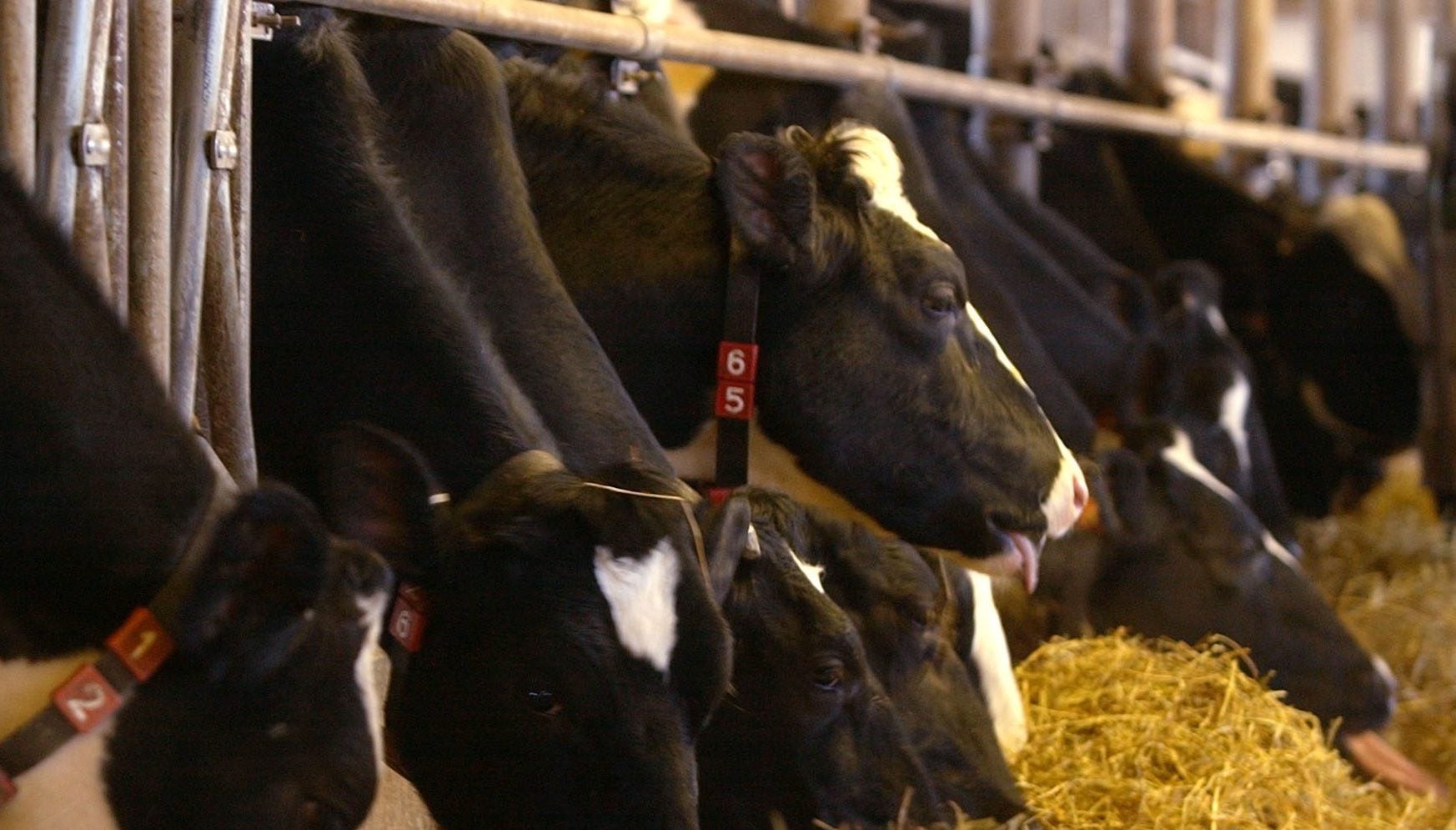Science
Record sea ice melt in Antarctica doomed thousands of penguin chicks to a watery grave

Emperor penguin chicks emerge from their eggs in the coldest days of Antarctica’s winter. For the first months of their lives the birds are defenseless gray fluffballs, seeking warmth at their parents’ feet or in protective scrums at the center of their colony.
Unlike their parents, whose sleek black-and-white feathers seal their skin against the frigid ocean, chicks’ downy plumage isn’t waterproof. They must stay atop the ice and away from the sea until their watertight feathers emerge, typically around four months after hatching.
By this time it’s December, and summer is arriving in Antarctica. The ice soon breaks up for the season, and the colony’s newest members can safely follow the adults into the ocean to hunt.
The survival of each new generation of emperor penguins relies on the presence of ice beneath those tiny feet. As many biologists have feared, the unseasonably early disappearance of Antarctica’s winter sea ice last year proved disastrous for the species.
Using satellite imagery, researchers found that four of five observed emperor penguin colonies in the Bellingshausen Sea region of western Antarctica experienced “catastrophic breeding failure,” meaning that no chicks born in 2022 are believed to have survived.
The complete demise of those four colonies is described in a paper published today in the journal Communications Earth & Environment.
After completing that research, lead author Peter Fretwell of the British Antarctic Survey said he examined satellite images of the remainder of the continent’s 66 known emperor penguin colonies.
In 19 of them — nearly 30% — most if not all of the chicks are believed to have drowned or frozen to death when the ice that once supported them melted into the sea, he said.
Although individual colonies will occasionally experience an isolated season of failed breeding, “this is the first time we’ve really seen a whole area be lost because of the sea ice,” said Fretwell, a mapping specialist.
The chicks were casualties of an unprecedented retreat of Antarctic sea ice. On Feb. 21, NASA recorded 691,000 square miles of summertime sea ice, an area 50,000 square miles smaller than the previous record set a year before.
It’s a record that seems likely to fall once again this year. The extent of Antarctica’s winter sea ice is smaller than it has ever been, with an area the size of Greenland simply missing from the coverage scientists expected. With less ice to start with, it’s very possible there will be less in the summer.
“It’s almost certain that this year is going to be worse than even 2022,” Fretwell said. “It’s a rather depressing story for emperor penguins.”
Until fairly recently, emperor penguins enjoyed a secure place in Antarctica’s ecosystem.
The continent is home to an estimated 600,000 individuals. The largest of Antarctica’s penguin species, emperors are distinguished in adulthood by their sleek black dorsal feathers, gold-streaked beaks and a resting posture that gives the impression of a bird looking regally skyward.
Until the advent of satellite imagery powerful enough to spot remote patches of ice with the telltale stains of penguin droppings, most of their colonies were entirely unknown to humans. Nearly half of today’s identified colonies were discovered in the last 15 years by Fretwell, who pioneered the science of penguin census-taking by satellite.
Ensconced on the ice, emperor penguins have largely avoided human efforts to hunt them, overfish their prey or encroach on their territory.
Still, scientists familiar with the species say it’s common for a colony to experience the occasional bad breeding season.
“Colony failures and early breakup of ice isn’t uncommon,” said Michelle LaRue, a marine biologist at New Zealand’s University of Canterbury who wasn’t involved in the research. Normally, it’s “a colony here and there, every once in a while,” she said. “Not like what Peter has just shown.”
For the study, Fretwell looked at satellite images of five known emperor penguin colonies in Antarctica’s Bellingshausen Sea region, which saw a particularly stark decline in sea ice last year.
The five colonies are collectively home to 7,000 to 10,000 breeding pairs of birds in any given year, Fretwell said. Starting in September, about a month after the chicks hatched, his team began examining images of the area taken every few days to few weeks.
By November, when the colonies’ chicks were still in their fluffy vulnerable stage, Fretwell noticed that sea ice that typically held into January was rapidly retreating. Prior data showed that only one of the five colonies had lost its ice during the four previous breeding seasons.
Last year was different. By early December, ice in four of the five colonies had dissipated entirely, forcing adult penguins to abandon the breeding ground early and consigning the chicks to a premature end.
In the Rothschild Island colony, home to the smallest population of the five, a lucky break in the bay’s geometry preserved the sea ice until the offspring of its roughly 700 breeding pairs had fledged.
It is “unprecedented,” Fretwell and his co-authors wrote, to see total breeding failure across an entire region. And the future looks even more bleak.
“Our sea ice models and penguin population projections suggest we’re going to lose over 90% of the colonies and well over 90% of the population by the end of the century,” Fretwell said.
Few creatures living at the poles are immune to the effects of climate change. But Antarctica’s largest penguin is profoundly vulnerable, biologists said, despite being generally tough birds.
“The Emperors are in big trouble,” said Steve Emslie, an expert in Adelie penguins at University of North Carolina Wilmington who was not involved in this research.
Without some sort of significant adaptation, such as moving to dry land to breed, emperor penguins “will continue to suffer breeding season losses from sea ice melting and breaking out too soon each year and the population will continue to decline,” Emslie said.
LaRue shared his concern.
“Emperor penguins tend to be quite resilient, but I don’t know how long that resilience can hang on given the extreme changes we’ve seen,” she said.
The colonies Fretwell observed aren’t large enough for this failed season to have a lasting impact on the species’ overall population, LaRue said. The bigger fear is that this collapse will turn out to be a bellwether for repeated failures in other colonies.
“They’re a window on the sea ice ecosystem,” Fretwell said of the emperor penguins. The birds’ future is directly tied to a warming sea and diminishing ice, both of which are happening faster than scientists predicted.
But their fate is not yet sealed, he said. If humans are able to reduce greenhouse gas emissions and stop global warming from continuing unabated, “we can change the fate of the emperor penguin and many other species,” he said, “including our own.”

Science
Cluster of farmworkers diagnosed with rare animal-borne disease in Ventura County

A cluster of workers at Ventura County berry farms have been diagnosed with a rare disease often transmitted through sick animals’ urine, according to a public health advisory distributed to local doctors by county health officials Tuesday.
The bacterial infection, leptospirosis, has resulted in severe symptoms for some workers, including meningitis, an inflammation of the brain lining and spinal cord. Symptoms for mild cases included headaches and fevers.
The disease, which can be fatal, rarely spreads from human to human, according to the U.S. Centers for Disease Control and Prevention.
Ventura County Public Health has not given an official case count but said it had not identified any cases outside of the agriculture sector. The county’s agriculture commissioner was aware of 18 cases, the Ventura County Star reported.
The health department said it was first contacted by a local physician in October, who reported an unusual trend in symptoms among hospital patients.
After launching an investigation, the department identified leptospirosis as a probable cause of the illness and found most patients worked on caneberry farms that utilize hoop houses — greenhouse structures to shelter the crops.
As the investigation to identify any additional cases and the exact sources of exposure continues, Ventura County Public Health has asked healthcare providers to consider a leptospirosis diagnosis for sick agricultural workers, particularly berry harvesters.
Rodents are a common source and transmitter of disease, though other mammals — including livestock, cats and dogs — can transmit it as well.
The disease is spread through bodily fluids, such as urine, and is often contracted through cuts and abrasions that contact contaminated water and soil, where the bacteria can survive for months.
Humans can also contract the illness through contaminated food; however, the county health agency has found no known health risks to the general public, including through the contact or consumption of caneberries such as raspberries and blackberries.
Symptom onset typically occurs between two and 30 days after exposure, and symptoms can last for months if untreated, according to the CDC.
The illness often begins with mild symptoms, with fevers, chills, vomiting and headaches. Some cases can then enter a second, more severe phase that can result in kidney or liver failure.
Ventura County Public Health recommends agriculture and berry harvesters regularly rinse any cuts with soap and water and cover them with bandages. They also recommend wearing waterproof clothing and protection while working outdoors, including gloves and long-sleeve shirts and pants.
While there is no evidence of spread to the larger community, according to the department, residents should wash hands frequently and work to control rodents around their property if possible.
Pet owners can consult a veterinarian about leptospirosis vaccinations and should keep pets away from ponds, lakes and other natural bodies of water.
Science
Political stress: Can you stay engaged without sacrificing your mental health?

It’s been two weeks since Donald Trump won the presidential election, but Stacey Lamirand’s brain hasn’t stopped churning.
“I still think about the election all the time,” said the 60-year-old Bay Area resident, who wanted a Kamala Harris victory so badly that she flew to Pennsylvania and knocked on voters’ doors in the final days of the campaign. “I honestly don’t know what to do about that.”
Neither do the psychologists and political scientists who have been tracking the country’s slide toward toxic levels of partisanship.
Fully 69% of U.S. adults found the presidential election a significant source of stress in their lives, the American Psychological Assn. said in its latest Stress in America report.
The distress was present across the political spectrum, with 80% of Republicans, 79% of Democrats and 73% of independents surveyed saying they were stressed about the country’s future.
That’s unhealthy for the body politic — and for voters themselves. Stress can cause muscle tension, headaches, sleep problems and loss of appetite. Chronic stress can inflict more serious damage to the immune system and make people more vulnerable to heart attacks, strokes, diabetes, infertility, clinical anxiety, depression and other ailments.
In most circumstances, the sound medical advice is to disengage from the source of stress, therapists said. But when stress is coming from politics, that prescription pits the health of the individual against the health of the nation.
“I’m worried about people totally withdrawing from politics because it’s unpleasant,” said Aaron Weinschenk, a political scientist at the University of Wisconsin–Green Bay who studies political behavior and elections. “We don’t want them to do that. But we also don’t want them to feel sick.”
Modern life is full of stressors of all kinds: paying bills, pleasing difficult bosses, getting along with frenemies, caring for children or aging parents (or both).
The stress that stems from politics isn’t fundamentally different from other kinds of stress. What’s unique about it is the way it encompasses and enhances other sources of stress, said Brett Ford, a social psychologist at the University of Toronto who studies the link between emotions and political engagement.
For instance, she said, elections have the potential to make everyday stressors like money and health concerns more difficult to manage as candidates debate policies that could raise the price of gas or cut off access to certain kinds of medical care.
Layered on top of that is the fact that political disagreements have morphed into moral conflicts that are perceived as pitting good against evil.
“When someone comes into power who is not on the same page as you morally, that can hit very deeply,” Ford said.
Partisanship and polarization have raised the stakes as well. Voters who feel a strong connection to a political party become more invested in its success. That can make a loss at the ballot box feel like a personal defeat, she said.
There’s also the fact that we have limited control over the outcome of an election. A patient with heart disease can improve their prognosis by taking medicine, changing their diet, getting more exercise or quitting smoking. But a person with political stress is largely at the mercy of others.
“Politics is many forms of stress all rolled into one,” Ford said.
Weinschenk observed this firsthand the day after the election.
“I could feel it when I went into my classroom,” said the professor, whose research has found that people with political anxiety aren’t necessarily anxious in general. “I have a student who’s transgender and a couple of students who are gay. Their emotional state was so closed down.”
That’s almost to be expected in a place like Wisconsin, whose swing-state status caused residents to be bombarded with political messages. The more campaign ads a person is exposed to, the greater the risk of being diagnosed with anxiety, depression or another psychological ailment, according to a 2022 study in the journal PLOS One.
Political messages seem designed to keep voters “emotionally on edge,” said Vaile Wright, a licensed psychologist in Villa Park, Ill., and a member of the APA’s Stress in America team.
“It encourages emotion to drive our decision-making behavior, as opposed to logic,” Wright said. “When we’re really emotionally stimulated, it makes it so much more challenging to have civil conversation. For politicians, I think that’s powerful, because emotions can be very easily manipulated.”
Making voters feel anxious is a tried-and-true way to grab their attention, said Christopher Ojeda, a political scientist at UC Merced who studies mental health and politics.
“Feelings of anxiety can be mobilizing, definitely,” he said. “That’s why politicians make fear appeals — they want people to get engaged.”
On the other hand, “feelings of depression are demobilizing and take you out of the political system,” said Ojeda, author of “The Sad Citizen: How Politics is Depressing and Why it Matters.”
“What [these feelings] can tell you is, ‘Things aren’t going the way I want them to. Maybe I need to step back,’” he said.
Genessa Krasnow has been seeing a lot of that since the election.
The Seattle entrepreneur, who also campaigned for Harris, said it grates on her to see people laughing in restaurants “as if nothing had happened.” At a recent book club meeting, her fellow group members were willing to let her vent about politics for five minutes, but they weren’t interested in discussing ways they could counteract the incoming president.
“They’re in a state of disengagement,” said Krasnow, who is 56. She, meanwhile, is looking for new ways to reach young voters.
“I am exhausted. I am so sad,” she said. “But I don’t believe that disengaging is the answer.”
That’s the fundamental trade-off, Ojeda said, and there’s no one-size-fits-all solution.
“Everyone has to make a decision about how much engagement they can tolerate without undermining their psychological well-being,” he said.
Lamirand took steps to protect her mental health by cutting social media ties with people whose values aren’t aligned with hers. But she will remain politically active and expects to volunteer for phone-banking duty soon.
“Doing something is the only thing that allows me to feel better,” Lamirand said. “It allows me to feel some level of control.”
Ideally, Ford said, people would not have to choose between being politically active and preserving their mental health. She is investigating ways to help people feel hopeful, inspired and compassionate about political challenges, since these emotions can motivate action without triggering stress and anxiety.
“We want to counteract this pattern where the more involved you are, the worse you are,” Ford said.
The benefits would be felt across the political spectrum. In the APA survey, similar shares of Democrats, Republicans and independents agreed with statements like, “It causes me stress that politicians aren’t talking about the things that are most important to me,” and, “The political climate has caused strain between my family members and me.”
“Both sides are very invested in this country, and that is a good thing,” Wright said. “Antipathy and hopelessness really doesn’t serve us in the long run.”
Science
Video: SpaceX Unable to Recover Booster Stage During Sixth Test Flight

President-elect Donald Trump joined Elon Musk in Texas and watched the launch from a nearby location on Tuesday. While the Starship’s giant booster stage was unable to repeat a “chopsticks” landing, the vehicle’s upper stage successfully splashed down in the Indian Ocean.
-

 Business1 week ago
Business1 week agoColumn: Molly White's message for journalists going freelance — be ready for the pitfalls
-

 Science6 days ago
Science6 days agoTrump nominates Dr. Oz to head Medicare and Medicaid and help take on 'illness industrial complex'
-

 Politics1 week ago
Politics1 week agoTrump taps FCC member Brendan Carr to lead agency: 'Warrior for Free Speech'
-
/cdn.vox-cdn.com/uploads/chorus_asset/file/25739950/247386_Elon_Musk_Open_AI_CVirginia.jpg)
/cdn.vox-cdn.com/uploads/chorus_asset/file/25739950/247386_Elon_Musk_Open_AI_CVirginia.jpg) Technology1 week ago
Technology1 week agoInside Elon Musk’s messy breakup with OpenAI
-

 Lifestyle1 week ago
Lifestyle1 week agoSome in the U.S. farm industry are alarmed by Trump's embrace of RFK Jr. and tariffs
-

 World1 week ago
World1 week agoProtesters in Slovakia rally against Robert Fico’s populist government
-

 Health3 days ago
Health3 days agoHoliday gatherings can lead to stress eating: Try these 5 tips to control it
-

 News1 week ago
News1 week agoThey disagree about a lot, but these singers figure out how to stay in harmony















